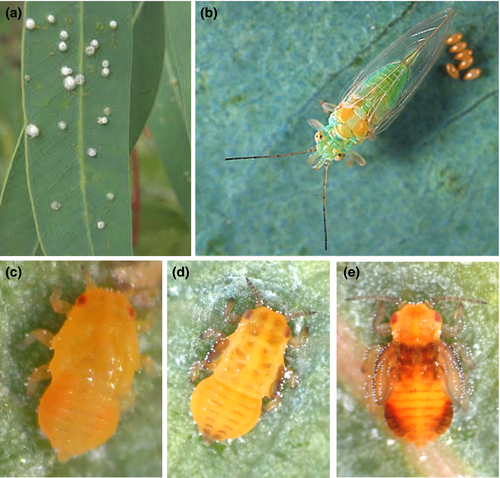First record of the red gum lerp psyllid, Glycaspis brimblecombei Moore (Hemiptera: Psyllidae), in Zambia
Introduction
Glycaspis brimblecombei Moore (Hemiptera: Psyllidae) is an important insect pest of Eucalyptus in many parts of the world (Brennan, Gill & Weinbaum, 1999; Queiroz, Burckhardt & Majer, 2012). This pest was first detected in 1998 outside its native range (Australia) in the U.S.A. (Brennan, Gill & Weinbaum, 1999). Since then, the pest has been reported from all continents (Queiroz et al., 2013; Milonas & Partsinevelos, 2014; Spodek et al., 2015). In Africa, G. brimblecombei has been reported from Algeria (Reguia & Peris-Felipo, 2013), Mauritius (Sookar, Seewooruthun & Ramkhelawon, 2003), Morocco (Maatouf & Lumaret, 2012), Tunisia (Ben Attia & Rapisard, 2014) and South Africa (Hurley & Greyling, 2013). Here, we report the species for the first time from Zambia.
Material examined
We collected adults, immatures and lerps in Zambia, Choma District of southern province, on infested trees of Eucalyptus grandis in September 2015. Voucher specimens are deposited at Copperbelt University, School of Natural Resources, Zambia. Detailed descriptions of G. brimblecombei are well known in the literature (Moore, 1970; Halbert, Gill & Nisson, 2001; Olivares, Burckhardt & Cerda, 2004; Burckhardt, Lozada & Diaz, 2008). To determine which species our specimens represented, we examined the shape of paramere in each specimen because Glycaspis species are diagnosable mostly by the paramere shape (Burckhardt, Lozada & Diaz, 2008). The paramere of each specimen examined was angled in the basal third and subacute apically. Infestations of G. brimblecombei are easily recognized by the conical white coverings (lerps) secreted by the nymphs. The psyllid nymphs are reddish bronze with darker wing pads that have bright white spots (Fig. 1). These descriptions were consistent with the Zambian specimens. Specimens were also sent to Daniel Burckhardt, Naturhistorisches Museum Basel, who confirmed the identity.

Infestation of Eucalyptus species in Zambia
In February 2014, a few lerps of G. brimblecombei were found on E. grandis trees planted for poles in the Choma District, Zambia. In September 2015, plantations of E. camaldulensis, E. tereticornis, E. grandis, E. citriodora, E. globulus and the Eucalyptus hybrid of E. grandis × E. tereticornis were inspected in several districts in southern and northern regions of the country. During inspection, infestations on Eucalyptus species were visually rated on a scale of 0 to 100% (i.e. low infestation, <35%; moderate infestation, 36–70%; and high infestation, >70%) based on the presence of immatures, lerps and severity of defoliation. Adults were excluded from the assessment due to their high mobility.
In the southern region, G. brimblecombei was discovered in the three districts Choma, Livingstone and Mazabuka with high infestation recorded in Choma where the damage observed was associated with severe leaf drop and twig dieback, while in Livingstone and Mazabuka infestation was low on Eucalyptus trees planted as windbreaks. Overall, high infestation was observed on E. camaldulensis and E. tereticornis, while E. grandis × E. tereticornis hybrids and E. grandis trees were moderately infested. The high infestations on E. camaldulensis and E. tereticornis observed in this study support the observation that these species are the most preferred hosts of G. brimblecombei (Brennan, Gill & Weinbaum, 1999; Brennam et al., 2001; Queiroz, Burckhardt & Majer, 2012). The lowest infestation was observed on E. globulus and there was no infestation on E. citriodora. This is not surprising as E. citriodora is known to possess strong plant volatiles with capabilities to repel a broad range of insects (Ribeiro et al., 2015). In the northern region, inspections were carried out in Ndola and Kitwe districts where no psyllids were found.
Modelling of the potential global distribution of G. brimblecombei by Queiroz et al. (2013) shows Zambia within the region of highest probability of occurrence. This region between the latitudes 20 and 40° in both hemispheres includes southern Africa, South America and almost the entire Australian continent. Although G. brimblecombei was only detected in the southern region of Zambia, its occurrence in the northern region is possible where it may become a serious pest, particularly in the Copperbelt Province, where E. grandis constitutes 90% of Eucalyptus plantations.
The integrated management of G. brimblecombei starts with continuous monitoring, which makes it possible to determine periods of population peak, the occurrence of natural enemies and other factors that affect the insect population (Queiroz, Burckhardt & Majer, 2012). Planting resistant species of Eucalyptus has also been shown to be an economically viable option to contain populations of G. brimblecombei (Brennan & Weinbaum, 2001). Biological control using parasitoids or predators has been very successful. For example, the Australian parasitoid, Psyllaephagus bliteus Riek (Hymenoptera: Encyrtidae), has been introduced into several countries (Daane et al., 2005; Bella & Rapisard, 2013) to control G. brimblecombei. Also the predator, Anthocoris nemoralis Fabricius (Hemiptera: Anthocoridae), native to Europe has been shown to be effective in the control of the psyllid (Erbilgin, Dahlsten & Chen, 2004). Due to overlapping generations of G. brimblecombei, chemical control is not effective because it requires successive spraying of insecticides (Santana & Burckhardt, 2007).
The red gum lerp psyllid, G. brimblecombei, is reported for the first time in Zambia. Even though it has been detected in three districts in the south, the spread of G. brimblecombei to other regions of the country is likely. To control G. brimblecombei and other forest pests in Zambia, there is an urgent need to establish an integrated pest management system that should involve the government, forestry companies and the research institutions.
Acknowledgements
We thank FAO for funding, Copperbelt University for the laboratory facilities and Forestry Department staff for field collaboration. Thanks go to Daniel Burckhardt (Basel) and an anonymous reviewer whose comments helped to improve this manuscript.




